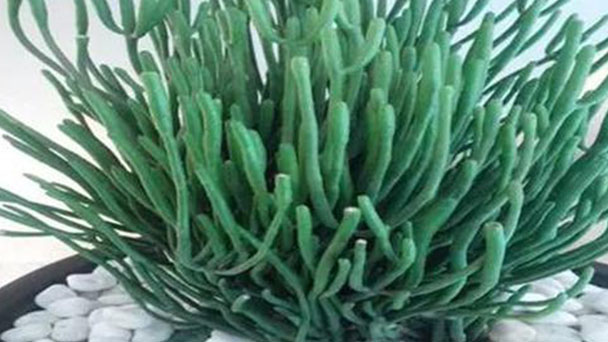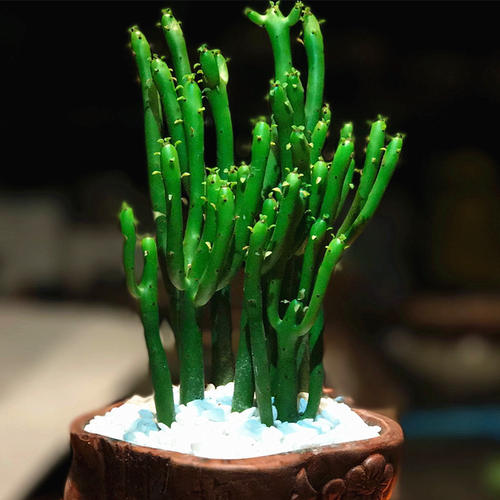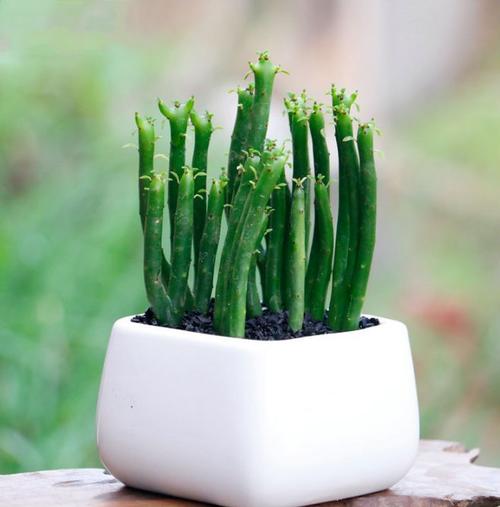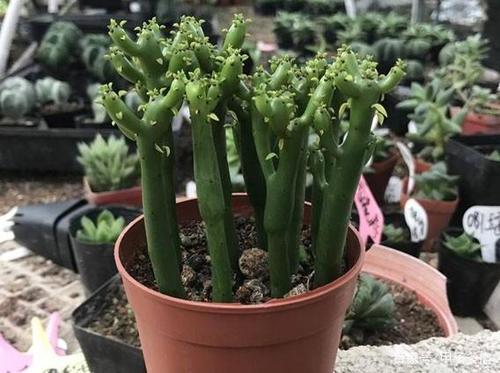Pencil Cactus (Euphorbia Tirucalli) Profile: Plant Info & Care Guide
Written by Maggie
Dec 07 2021

Pencil Cactus, scientific name Euphorbia Tirucalli, is a succulent woody plant belonging to the Euphorbiaceae family, native to the arid tropical regions of East and South Africa. The whole tree has no flowers or leaves, with only bare branches, just like sticks sticking into the tree. Therefore, people nicknamed it "Pencil Cactus", while others call it "green jade tree" or "fairy stick". Pencil Cactus is also called a "milk tree" because its stem contains milky SAP. The white milk in its stem can be used to make petroleum.
Pencil Cactus is rich in twelve hydrocarbons, similar in composition to petroleum, and contains no sulfur. pencil cactus can be mixed directly or with other substances to form crude oil.It can also be used as a raw material for biogas production, and its biogas production is 5-10 times higher than the general green grass.
The white milk of Pencil Cactus is highly toxic and requires special care when viewing or growing.
Pencil Cactus is a petroleum plant, a medicinal plant, and an ornamental plant. Because of drought resistance, salt resistance and wind resistance, commonly used as a seaside windbreak or landscaping trees.
Pencil Cactus Picture

Pencil Cactus Features
Pencil Cactus is a shrub or small tree, erect, up to 4 to 9 meters tall, with white milk in the whole plant. Branchlets are opposite or subwhorled, green, slightly fleshy. Leaves are minute alternate, oblong-linear, 7 -- 15 mm long, 0.7 -- 1.5 mm wide, apex obtuse, base tapered, entire, sessile or subsessile; Often on young shoots of the same year, sparsely and rapidly falling off. Linear or reduced to inconspicuous scales, or a few scattered branchlike tips. Pencil Cactus is about 1 cm long and 0.2 cm wide, falling early to reduce water evaporation, so it is often leafless.
Pencil Cactus inflorescences are dense at branch apex, base stipate. Involucral bracts aregyroscopic, ca. 2 mm high, ca. 1.5 mm in diam., medially pubescent; Pencil Cactus has 5 glands, peltate ovate or suborbicular. Inflorescence is cup-shaped cymes, terminal or axillary, involucre thousand membranous, caducous. Male flowers of Pencil Cactus are several, out of involucre; Female flowers 1, ovary stalk protruding involucre margin; Ovary is 3-loculed, ovary smooth glabrous; Pencil Cactus has 3 styles, connate below middle; Stigma is 2-lobed. Capsule is angulate, ca. 8 mm in length and diameter, smooth, slightly glabrous or glabrous. Seeds of Pencil Cactus are ovoid, ca. 4 mm in length and diameter, smooth;
Pencil Cactus is gray or grayish when old and green when young, with a flat or branched upper part. Stem is exercise photosynthetic function, so often a leafless state.Its leaves are a variant of the leaf. Because of its branches green, smooth, shiny, so people also called it as green jade or green coral. Although Pencil Cactus lacks green leaves, the branches of Pencil Cactus contain plenty of chlorophyll, which acts as a substitute for leaves for photosynthesis. However, if Pencil Cactus were planted in a warm, humid area, it might adapt to wet conditions by growing small leaves that would evaporate excess water. In order to reduce water evaporation, leaves gradually degrade or even disappear; Branches turn green and act as light substitutes for leaves.
The branches of Pencil Cactus are cylindrical green with opposite or whorled branches that photosynthesize in place of leaves when there are no leaves.
Pencil Cactus Habits
Pencil Cactus is warm (25-30 degrees), tolerant to drought, salt and wind, good light, and can grow in poor soil. Due to the low flowering and bearing rate, the cuttage method is used to propagate. It is easy to take root in warm climates. Pencil Cactus can be planted in the open air in warm areas in the south and in greenhouse in the north.
The hometown of Pencil Cactus is in the arid region of Africa, where there is very little rain all the year round and there is very little water. In order to preserve and fight the drought, the leaves of Pencil Cactus gradually become smaller and even disappear. In this way, the body can reduce the evaporation of water, greatly save water.In order to survive and produce organic matter, its branches turn green to photosynthesize instead of leaves. This characteristic of Pencil Cactus is a special drought-resistant ability gradually formed in order to adapt to the harsh natural conditions and living environment.
Pencil Cactus also grows large and abundant leaves just like plants in places with humid climate and abundant rain. As a result, Pencil Cactus will lose a lot of water due to transpiration of leaves, so it cannot adapt to drought and will be eliminated by nature.In addition, its deadwood appearance is unattractive to some leaf-eaters, reducing the chance of being eaten by animals.
Pencil Cactus Propagation
Because Pencil Cactus had a low flowering and bearing rate, it was mostly propagated by cuttings. Pencil Cactus is easy to take root in warm climates. Pencil Cactus can be planted in the open air in the south and in the greenhouse in the north.
Commonly used cutting propagation, suitable for good drainage soil. It is advisable to choose 2/3 of the leaf rot soil and 1/3 of the garden soil mixed and add a small amount of river sand as the culture soil, pot bottom can put a little hoof and other long-acting fertilizer, as a base fertilizer.In order to facilitate drainage, the basin bottom should also pad a few gravel or tile.
Cut off the thick and solid top branches, and take 2 stem segments (8-10cm in length) as cuttings. Dry them a little and then insert them into a sand bed. Use yellow sand or perlite as the medium, or use well-drained sandy loam. Root about 3 weeks after insertion. Single leaf cuttings can also be used, after cutting the leaves to be dried. Then inserted into the sand bed, easy to root in warm conditions. Root about 4 weeks after insertion, and put into the pot when the root length is 2~3cm. Rooted, it can be planted in pots of 10 to 15cm.It can be cultivated in the open field in the warm areas in the south, and in the greenhouse in the Yangtze River valley and the areas to the north. It is generally cultivated in the greenhouse in winter and in the open air in summer.
Pencil Cactus Care
Pencil Cactus likes a warm and sunny environment. It is drought, salt and wind resistant. The suitable temperature for growth of Pencil Cactus is 25-30℃. When we care for Pencil Cactus in winter, it can be moved to indoor maintenance, summer can be cultivated in the open air.
Soil for Pencil Cactus
Pencil Cactus requires soil with good drainage and air permeability. When we care for Pencil Cactus, the soil for home potting can be mixed with leaf rot soil, sand soil and perlite as potting medium. In order to ensure the growth of Pencil Cactus, an appropriate amount of organic fertilizer can be added to the medium.
Pencil Cactus Light Requirements
Pencil Cactus is fond of light and warm environments, so sufficient light should be provided during maintenance. When we care for Pencil Cactus in the hot summer, to avoid strong light exposure, summer needs appropriate shading processing.
In winter, the light is weak, so it is necessary to place Pencil Cactus in a sunny place at noon in warm weather in winter to fully enjoy the sunlight.
Pencil Cactus Watering
Pencil Cactus is drought-resistant and should not be watered too much in the curing process. Every time you water Pencil Cactus, you only need to keep it slightly moist. Water is usually done after the soil is fully dried.
When we care for Pencil Cactus in the spring to fall season, you can water every 1 to 2 days. When watering, make sure the soil is fully dry and then water .In summer, the temperature is high, and the moisture is relatively fast, so you can appropriately increase some moisture.
During the winter, the soil stays slightly dry.
Pencil Cactus Fertilizer Care
When we care for Pencil Cactus, in order to ensure the good growth of Pencil Cactus, fertilizer can be applied every half a month to supplement nutrients in time, which is conducive to the growth of Pencil Cactus.
Repotting Pencil Cactus
Generally, Pencil Cactus can go out of the greenhouse in spring of every year. Pencil Cactus potted plants that have been kept for 1-2 years need to be turned once and replaced with new loose sandy loam soil.

Pencil Cactus Disease Control
The main diseases of Pencil Cactus are charcotylus and leaf spot, which can be sprayed with 70% methyl tobutin wettable powder 1000 times liquid.Indoor ventilation is poor, the stem and leaves are vulnerable to scale insect harm, spray with 40% oxidized diogo emulsion 1000 times liquid.
When watering too much, easy to cause root rot, leaves will be yellow, or even gray mold and rot, should pay attention to ventilation and drainage, when necessary, can spray carbendazim wettable powder control.In addition, mealybug can also harm the leaves and form white wax powder, so it is necessary to eliminate the disease and insect leaves in time to prevent their spread.
Pencil Cactus Distribution
Pencil Cactus originated from the Mediterranean coast of Africa and is found in Hong Kong, Penghu Islands, Hainan, the United States of America, Malaysia, India, the United Kingdom and France.
Pencil Cactus is widely cultivated in the tropics and subtropics, and even becomes wild.Both north and south of our country are cultivated, or as a street tree (south) or greenhouse cultivation and ornamental (north).
Pencil Cactus is cultivated in the provinces and regions south of the Yangtze River Basin in China.
Pencil Cactus Toxic
The white milk of Pencil Cactus is highly toxic, and special care should be taken when watching or cultivating it. Pencil Cactus should not be allowed to enter people's mouth, ears, eyes, nose or wounds. However, such poisonous milk can resist the invasion of viruses and pests, thus protecting the trees. In addition, milk has the role of promoting tumor growth, by promoting human lymphocyte chromosome rearrangement and carcinogenesis; Irritation of the skin can lead to redness and swelling, and contact with the eyes can lead to temporary blindness.
Toxic milk contains phorbosol - 12,13 - unsaturated diester compounds, 4- deoxyphorbosol - 12,13 - unsaturated diesterification compounds, dandelion sterol, 13- letosterol, Euphorbiol, etc.
Pencil Cactus is all herbal medicine. It is cool, pungent and slightly sour. The main treatment for pregnant women postpartum lack of milk, tinea and joint swelling pain. The whole strain contains toxic emulsion. Emulsion can be used as emetic and purgative, but strong skin contact can cause skin inflammation, redness, itching and pustules, and has antibiotic effect on Staphylococcus aureus. (Read More about Pencil Cactus Toxic)
Pencil Cactus Uses
The raw material
The remaining fibers of Pencil Cactus after juicing can be used as raw materials for paper making, and the white milk in the stem can be used to make biodiesel. Pencil Cactus is an energy plant with low pollution and renewable efficiency and environmental protection.
Social value
Pencil Cactus White Emulsion is rich in twelve hydrocarbons, similar in composition to petroleum, and contains no sulfur. Pencil Cactus White Emulsion can be mixed directly or with other substances to form crude oil. It can also be used as a raw material for biogas production, and its biogas production is 5-10 times higher than the general green grass.
Ecological value
Because of Pencil Cactus tolerance to drought, salt and wind, and its ability to grow in poor soil, it is often planted in areas with little rain. Not only can it be used for forestation and soil conservation, but it can also be used for oil production. In the early 1980s, in order to adjust the agricultural structure in arid areas and prevent soil erosion, Kenya carried out the research and development of important energy plants in arid areas, and screened out the most suitable energy plant for planting in arid and semi-arid areas -- Cylindrome. It can be seen that the green jade tree has a certain ecological role.
The economic value
The milk of Pencil Cactus is rich in hydrocarbons, and the composition is similar to petroleum. Studies have pointed out that 100kg of Pencil Cactus stems can extract 8kg of petroleum substances. Pencil Cactus branches are rich in milk, rich in twelve kinds of hydrocarbon substances, and milk is rich in alkenes, terpenes, sterols and other hydrocarbons similar to petroleum composition, can be directly or mixed with other substances into crude oil, as a fuel oil instead of oil. So the Pencil Cactus is a kind of petroleum plant. It can also be used as the raw material of biogas production, and its biogas yield is 5~10 times higher than the general green grass.
In gardens
Pencil Cactus is drought, salt and wind tolerant, and is often used as a beach windbreak or landscaping tree. Pencil Cactus stem bald net, smooth, cylindrical, no leaves, is a more exotic look at the stem plants.

Latest Updated
- Benefits of Bugleweed - 7 Science-backed Health Benefits
- Bugleweed Dangers & Side Effects - Is It Poisonous?
- How to Plant Evergreen Trees - What You Should Know
- When to Plant Evergreens - Grow Guide for Evergreen Trees
- 12 Wonderful Evergreen Shrubs for Your Garden
- 12 Popular Evergreen Plants with Pictures for Beginners
- When And How To Prune A Lilac Bush Like a Pro
- How to Grow & Care for Lilac Vine (Hardenbergia Violacea)
- Japanese Lilac Tree (Syringa Reticulata) Care & Propagation Guide
- Shumard Oak Pros and Cons - What to Know
Popular Articles
- Winter maintenance of Antirrhinum Majus
- How to Grow Terminalia Mantaly Tree
- How to Grow and Care for Crossostephium Chinense
- How to grow Antirrhinum Majus in spring
- Peristeria Elata (Dove Orchid) Profile: Info & Care Guide
- Underwatered Snake Plant (Sansevieria Trifasciata) - Signs And How To Fix
- How to Care for Brazilian Jasmine Plant (Mandevilla Sanderi)
- How to Grow & Care for Graptopetalum Purple Delight in Summer
- Rosa Chinensis (China Rose): Plant Growing & Care Tips
- How to Care for Baby Sun Rose (Aptenia Cordifolia)